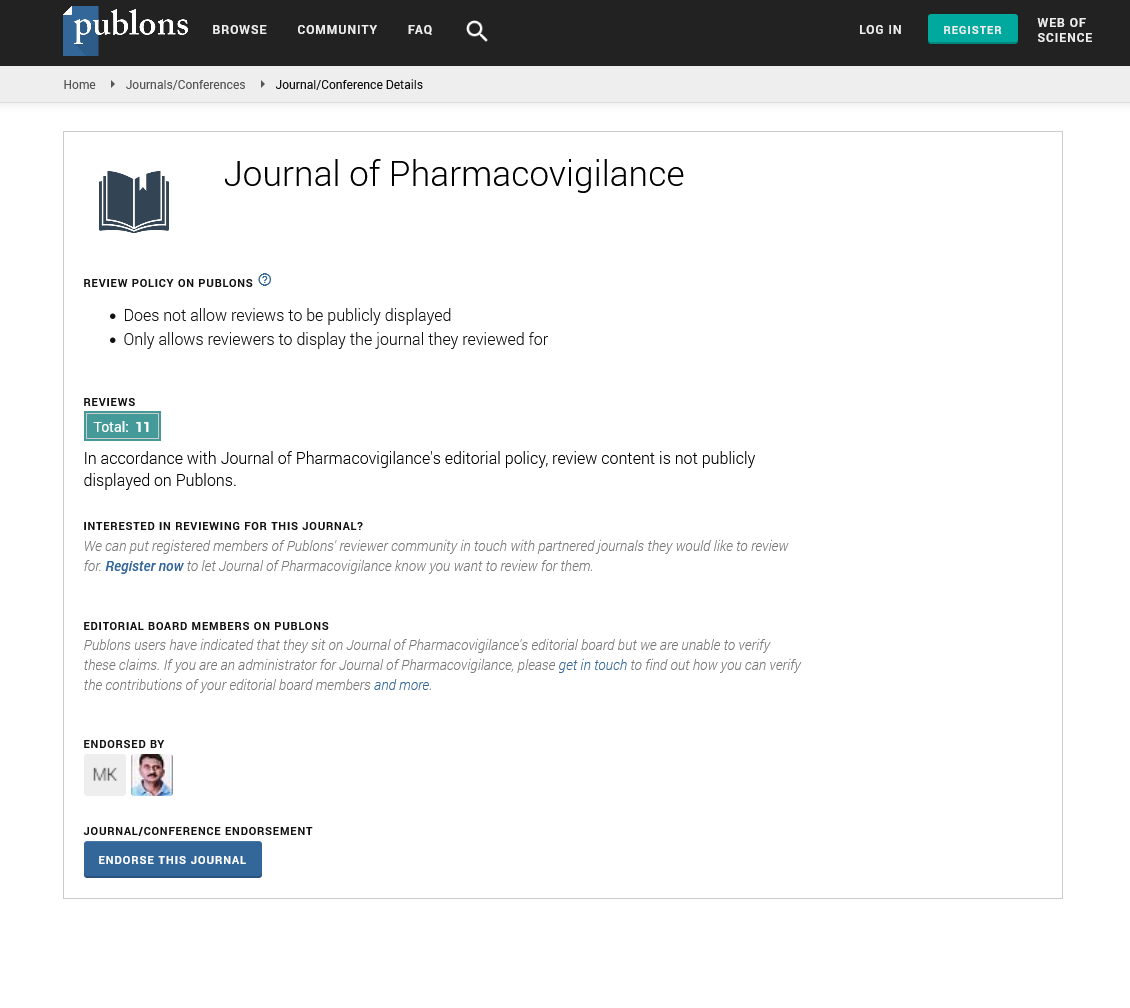Indexed In
- Open J Gate
- JournalTOCs
- The Global Impact Factor (GIF)
- RefSeek
- Hamdard University
- EBSCO A-Z
- OCLC- WorldCat
- Publons
- Euro Pub
- Google Scholar
Useful Links
Share This Page
Journal Flyer

Open Access Journals
- Agri and Aquaculture
- Biochemistry
- Bioinformatics & Systems Biology
- Business & Management
- Chemistry
- Clinical Sciences
- Engineering
- Food & Nutrition
- General Science
- Genetics & Molecular Biology
- Immunology & Microbiology
- Medical Sciences
- Neuroscience & Psychology
- Nursing & Health Care
- Pharmaceutical Sciences
Perspective - (2024) Volume 12, Issue 2
Enhancing Patient Engagement in Adverse Drug Reaction Reporting
Ichikawa Yoichiro*Received: 29-May-2024, Manuscript No. JP-24-25989; Editor assigned: 31-May-2024, Pre QC No. JP-24-25989(PQ); Reviewed: 14-Jun-2024, QC No. JP-24-25989; Revised: 21-Jun-2024, Manuscript No. JP-24-25989(R); Published: 28-Jun-2024, DOI: 10.35248/2329-6887.24.12.482
About the Study
Adverse Drug Reactions (ADRs) pose a significant public health concern. Patient reporting is essential for comprehensive pharmacovigilance and ensuring medication safety. However, underreporting remains a major obstacle. This manuscript explores strategies to enhance patient engagement in ADR reporting. We discuss the current landscape of patient reporting, barriers to participation, and propose a collaborative approach that utilizes education, technology, and optimized reporting systems.
ADRs, unintended and undesirable effects of medications, are a growing public health concern. Patient reporting of ADRs is a fundamental of pharmacovigilance, the process of monitoring drug safety after-market authorization. Increased reporting allows for earlier detection of safety signals, leading to improved drug safety profiles and better patient outcomes. Unfortunately, underreporting of ADRs remains a widespread issue, hindering the effectiveness of pharmacovigilance efforts.
Many patients lack knowledge about ADRs or the significance of reporting them. Patients may struggle to differentiate between ADRs and normal medication side effects, often attributing symptoms to other causes. Existing reporting processes can be complex and time-consuming, discouraging participation. Patients may fear being judged for medication non-compliance or believe reporting won't make a difference.
A multifaceted approach that addresses these barriers and leverages collaboration between healthcare professionals and patients is crucial to enhance patient engagement in ADR reporting. Here are some key strategies:
Public health campaigns, developed in collaboration with patient advocacy groups, can educate patients on ADRs, their importance, and available reporting mechanisms. Educational materials should equip patients with the tools to recognize potential ADRs, encourage communication with healthcare providers regarding concerns, and simplify the reporting process. Mobile apps and user-friendly web platforms can facilitate easy and convenient ADR reporting. Gamification elements can further increase engagement and encourage timely reporting.
Simplifying existing reporting systems is essential. Accessibility can be enhanced by offering multiple reporting channels, including online platforms, mobile apps, and paper forms. Consideration should be given to anonymous reporting options to address patient concerns. Integration with Electronic Health Records (EHRs) could further streamline the process for both patients and healthcare providers.
Addressing patient concerns about potential repercussions and emphasizing the importance of confidentiality is vital to building trust in the reporting system. Communicating the positive impact of patient reporting on medication safety can further incentivize participation.
Healthcare professionals play a critical role in encouraginging a culture of patient engagement in ADR reporting. Here are some ways healthcare professionals can contribute:
Routinely discussing ADRs with patients during consultations and providing clear reporting guidelines can significantly improve reporting rates. Healthcare institutions can provide patients with readily accessible reporting forms and information on available reporting channels. When possible, providing patients with feedback on the investigation and outcome of their reports can demonstrate the value of their contribution and encourage continued reporting.
Conclusion
Enhancing patient engagement in ADR reporting requires a collaborative approach that addresses awareness, accessibility, and patient concerns. By implementing a multifaceted strategy that utilizes education, technology, and streamlined reporting systems, alongside collaboration with healthcare professionals, we can create a culture of active patient participation in pharmacovigilance. This will empower patients, improve medication safety, and ultimately lead to a safer medication environment for all.
Citation: Yoichiro I (2024) Enhancing Patient Engagement in Adverse Drug Reaction Reporting. J Pharmacovigil. 12:482.
Copyright: © 2024 Yoichiro I. This is an open-access article distributed under the terms of the Creative Commons Attribution License, which permits unrestricted use, distribution, and reproduction in any medium, provided the original author and source are credited.

